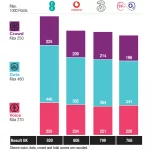Wi-Fi Alliance Stakes Claim to 6GHz Band for Faster Home WiFi

The Wi-Fi Alliance has begun its campaign to nudge broadband and telecoms regulators from across the world to support their efforts to approve the 6GHz band for use alongside WiFi networks, which could in theory be introduced into the latest Wi-Fi 6 (802.11ax) standard alongside the Wi-Fi 6E terminology.
At present the new 802.11ax standard, which is only in the early stages of commercial availability, promises theoretical peak data speeds of 10Gbps (Gigabits per second) via the combined 2.4GHz and 5GHz radio spectrum bands, as well as better management of spectrum in congested environments, faster latency, improved power efficiency and various other changes (see our summary).
In reality Wi-Fi is still hobbled by the limits of its existing spectrum and the best way to improve performance is usually to add more. In that sense the alliance believes that introducing the 6GHz band would provide for a set of larger contiguous spectrum blocks to accommodate 14 additional 80MHz channels and 7 additional 160MHz channels (they may not get all of this in every country).
Advertisement
The 6GHz band, being of a higher frequency than the others, would of course have a lower level of coverage than the 5GHz one. On the flip side this lower coverage would also make it more secure for homes and reduce the negative impact from congestion via competing local network signals.
Phil Solis, IDC Research Director, said:
“If the regulatory landscape permits, we expect companies to move forward aggressively with products that operate in 6 GHz because they understand the tremendous value brought to their customers by this portion of unlicensed spectrum.
If spectrum is made available early this year, we expect momentum of products that support operation in 6 GHz to ramp very quickly. The capacity of 6 GHz is enormous and will be efficiently used by Wi-Fi 6 and newer versions of Wi-Fi. The U.S. is taking a big lead on the 6 GHz market, with Europe and APAC regions also exploring access to this band.”
Edgar Figueroa, Wi-Fi Alliance President and CEO, said:
“6 GHz will help address the growing need for Wi-Fi spectrum capacity to ensure Wi-Fi users continue to receive the same great user experience with their devices.
Wi-Fi Alliance is introducing Wi-Fi 6E now to ensure the industry aligns on common terminology, allowing Wi-Fi users to identify devices that support 6 GHz operation as the spectrum becomes available.”
A number of regulators across the world are known to be keeping an open mind to this and some seem to be proceeding toward adoption, although 6GHz is already quite widely used by various different services including fixed wireless links (in theory some of those services might have to be moved out of the current bands if future sharing is unlikely to be possible).
Ofcom has previously designated various parts of spectrum above 6GHz (up to 100GHz) as being potentially useful for mobile services, although the regulator’s most recent 2018 review of fixed wireless spectrum proposed no major changes to either the Upper 6GHz (6425-7125MHz) or Lower 6GHz (5925-6425MHz – this is where Wi-Fi 6E would sit) bands; except for potentially using some band gaps for low capacity options.
However Ofcom, in reacting to a meeting of the IEEE 802 LAN/MAN Standards Committee, did “agree with the view that co-existence studies would first need to be completed at 6GHz to understand the feasibility of sharing between existing and new uses before a decision is made to facilitate RLANS in 5925-7125 MHz.” We have asked Ofcom for an update on their position and will report back if they respond.
Advertisement
Certainly faster WiFi speeds would no doubt be welcomed by most consumers, especially those lucky few who have just splashed out on a gigabit-capable “full fibre” (FTTP) broadband ISP line. Wireless performance remains a significant local network hindrance to fibre connections, unless you’re practically sitting on top of the router.
UPDATE 4:01pm
A spokesperson for Ofcom told ISPreview.co.uk: “We have been analysing how parts of the 6GHz band could be used for other services such as Wi-Fi, without interfering with existing users of the band. We’re planning to publish an update on next steps for this work, shortly.”
Mark is a professional technology writer, IT consultant and computer engineer from Dorset (England), he also founded ISPreview in 1999 and enjoys analysing the latest telecoms and broadband developments. Find me on X (Twitter), Mastodon, Facebook, BlueSky, Threads.net and Linkedin.
« Ofcom UK Propose Predictable Annual Work Plan for 2020-21























































6GHz frying you?
Non-ionizing 6GHz can not fry you, unless a lot of power is put behind the signal (i.e. way above the allowed power levels) and you’re at extremely close range (like inside a Microwave Oven).
This is great, but many still don’t know the difference between 2GHz & 5GHz bands. At home I only use the 5ghz band as it’s got more capacity. Especially important for building a smart home.
If we get 6ghz then I think we should be given the option to increase the power levels to get full home coverage. 5ghz already needs WiFi extenders added around the home.
Also… Tin foil hat people will start paniking! They need to learn the basics of bands we use for data & the difference between non ironising & Ironising bands.
The confusion is likely to be less of an issue once 802.11ax becomes mainstream as it works to combine all the bands via a more seamless approach. So I imagine 6GHz would just add into that.